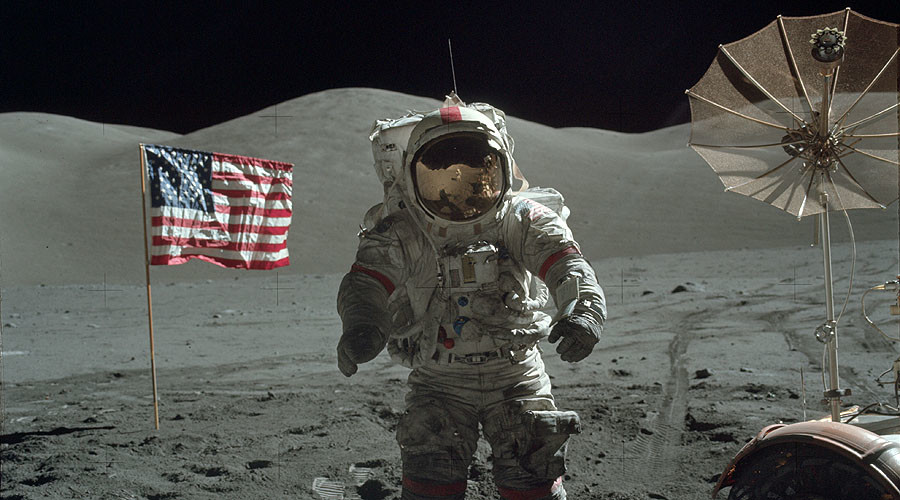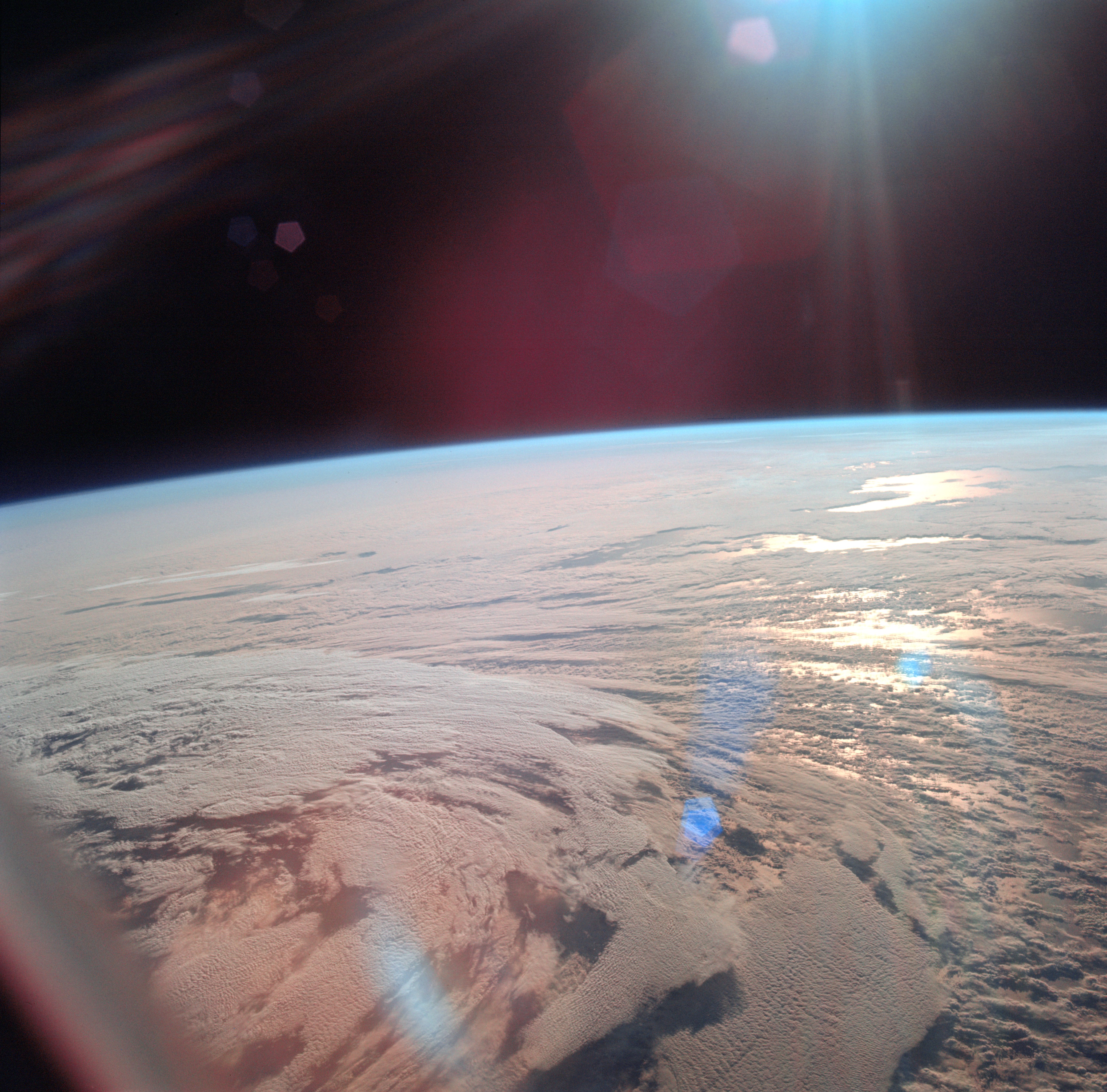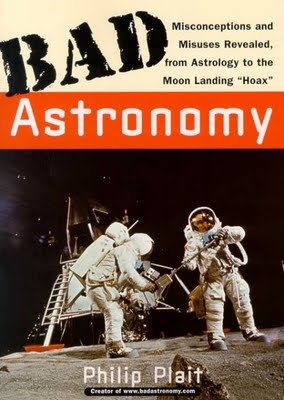Review: Bad Astronomy

“Do you see the pattern? First the Earth was the center of everything-hurrah! Then, well, ahem. Maybe the Sun still is-yay! But then, yikes, actually we’re way out in the suburbs of the [Milky Way] Galaxy. Well, this was getting downright insulting.”
A casual spin of the Google directory returns over 600,000 results for “moon landing hoax.” Naturally, some portion of these hits are by the debunkers, those war-torn heroes who continue to throw logic and sense at the convinced conspiracy cults. Yet even discounting the lights of reason embedded in these results, the fact remains that far too many still believe that America’s voyage to the moon was no voyage at all: 6% of Americans, to be precise.
At first brush, and consumed without much in the way of science literacy, some of the doubts offered by hoaxers can sound marginally compelling. But first glances can be deceiving. And be warned: If you do wade into this cesspool of credulity, you may find yourself in contact with ideas that would make Roswell truthers blush. ‘The whole moon itself is faked and is projected onto the sky using the same technology used to project the Bat Signal’. Or something just as otherwordly. Conspiracy wonks are nothing if not creative, but you may find such departures from Reality unfit for public consumption. Don’t venture too long.
To be sure, collapsing the arguments of moon landing deniers requires little more than a healthy dose of common sense infused with trace amounts of scientific acumen. They might try the following on for size:
1. Experts spanning the fields of astronomy, astrophysics, and photography all say we’ve been to the moon, and it’s usually a good idea to defer to experts on matters in which you are, in fact, not one.
2. Global conspiracy theories on the scale necessary to fake a moon landing are probably infeasible given how many people would need to stay silent, from the hundreds of thousands of NASA engineers who worked on the Apollo project for nearly 10 years, the staging crews who fabricated and processed the footage for six different manned landings, the 12 men who claimed to have walked on the moon and the other astronauts who flew with them, and finally to the chain of command terminating with the Oval Office.
3. If the Soviet Union had the slightest inkling of imposture, they would have trumpeted it from the rooftops to the stars. We were, after all, waging an international space race at the time.
4. Photographic chicanery of the type required to spoof a moon landing did not exist.
5. Along with much third-party evidence, in recent years orbiting spacecraft have captured photos of the landing sites, the tracks left by the Apollo astronauts, and various remnants of the lunar surface experiments they conducted.
If exercising logic and countering similarly pseudoscientific moonshine is something you work into regular rotation, you’ll find Bad Astronomy: Misconceptions and Misuses Revealed, from Astrology to the Moon Landing “Hoax” crowded with thrills and long on ammunition. In a way, this is the book Phil Plait, award-winning blogger and skeptic superstar, was always meant to write. The topics covered are the very ones he’s written vibrantly about for more than a decade on his blog of the same name (now appearing on Slate). Fans of his work will be accustomed to the serviceable combination of wit, humor, and academic rigor directed at popular misinformation. His easily digestible tome is in this sense perfectly continuous with his veteran crusade to debunk all manner of ‘bunk’.
Astronomy is Plait’s specialty, and his breadth of the stars is staggering. Sure, much of the information on offer here is a Google search away, but the comedic, accessible format and the assortment of diverse but neatly divisioned topics prove to be the book’s redeeming qualities. And along with a pulverizing exposé on moon landing conspiracy theories, about a quarter of the way into the book you’re treated with one of the best, if not the best, layman explanations of how tides work. Given all of the half-explanations and untruths swirling around online on this topic (Plait notes that even many textbooks have it wrong), it’s refreshing to read a comprehensive breakdown of tidal physics that even an amateur can regurgitate. His deconstructions really are that good.

“The essence of science is that it makes its own improvements: A theory is only as good as its next prediction.” (p. 20)
While we cannot be faulted for it, most of us live out our day entirely ignorant of the celestial wonders that loom just beyond the horizon. The sun, and the planets that race around it, each with its loyal retinue of moon or moons, all dance to intricate patterns and are governed by a dense filigree of physical relationships. Plait does a great job of exposing the profundity of the stars to which we are so often oblivious while putting to bed a few of the most pervasive inaccuracies lodged in our modern consciousness.
As it turns out, the seasons are not caused by the sun’s intensity or by its distance from the earth. The moon is not larger near the horizon than when it’s high overhead. Lunar phases are not the result of the earth’s shadow dynamics. The sky is not blue because it reflects the color of the oceans. And, far from proving that no man has stepped foot on the surface of the moon, the fact that there are no stars in the Apollo 11 photographs simply shows that NASA knew how to work a camera. Plait’s treatments are precise, no-nonsense and layered with enthusiasm.
Some chapters are less memorable than others: why you can balance an egg on its end any day of the year; why you can’t glimpse stars in daylight; and why astrology carries as much science cred as Harry Potter struck me as less than revelatory. However, the sections on the Hubble Space Telescope, the “Velikovsky affair,” the Big Bang — perhaps the most frequently misconceived of scientific theories — and his entertaining finale on bad astronomy in film all earn high marks.
Closing Thoughts
If you find science synonymous with entertainment, then Bad Astronomy is for you, especially if you’re already familiar with Phil Plait’s online persona. Not merely the arch-critic of pseudoscience, Plait is one of the few educators I know of who can graft humor onto science without falling victim to oversimplification or pulling from the standard bag of clichés. You won’t just learn that the sky is blue because the earth’s atmosphere scatters blue light more than other wavelengths, or that 2001: A Space Odyssey is the most scientifically authentic space movie ever. You’ll also obtain a wonderful introduction to the underlying principles of astronomy and appreciate the admixture of humor throughout. Plait’s book, his first, is an exercise in clear thinking fused with good science, necessities surely foreign to the moon landing deniers. Highly recommended.
Note: This review is mirrored over at Goodreads and at Amazon.
Phil Plait’s Bad Astronomy column
Supplement with: Neil deGrasse Tyson and Joe Rogan Debate Moon Landings



Comments